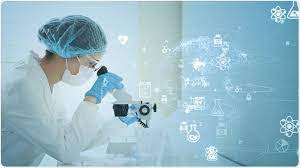The Rise Of RUBMD: Revolutionizing Healthcare Through AI
Table of Contents
In recent years, the healthcare industry has witnessed a seismic shift in the way medical professionals diagnose and treat patients, and much of this transformation can be attributed to the advent of cutting-edge technologies.
One such technology that has been gaining immense traction is RUBMD – an advanced AI-powered medical platform that promises to revolutionize healthcare delivery.
In this article, we delve into the world of RUBMD, exploring its unique capabilities, potential applications, and the impact it may have on the future of healthcare.
The Emergence of RUBMD:
RUBMD, a product of years of research and development, emerged as a groundbreaking solution that combines artificial intelligence and machine learning algorithms.
This powerful combination allows RUBMD to analyze vast amounts of medical data quickly and accurately, enabling medical practitioners to make informed decisions with unprecedented precision.
Unveiling the Potential:
RUBMD’s capabilities are nothing short of extraordinary. From diagnostics to personalized treatment plans, the platform offers an array of applications that can enhance patient outcomes significantly.

Through its state-of-the-art algorithms, RUBMD can swiftly analyze medical imaging, lab reports, and patient histories, providing healthcare professionals with invaluable insights in real time.
Streamlining Diagnostics:
With RUBMD, the traditional and time-consuming process of diagnosing patients is undergoing a rapid transformation. By harnessing the power of AI, RUBMD can detect patterns and anomalies in medical data that might go unnoticed by human eyes.
As a result, medical practitioners can now arrive at accurate diagnoses faster, potentially saving precious time in critical situations.
Personalized Treatment Approach:
Transitioning from a one-size-fits-all treatment approach, RUBMD advocates for personalized medicine. By considering a patient’s genetic makeup, medical history, and lifestyle factors, RUBMD can tailor treatment plans to suit individual needs.
This targeted approach not only enhances treatment effectiveness but also minimizes adverse reactions, ultimately improving patient well-being.
Enhanced Medical Imaging:
Medical imaging plays a pivotal role in diagnosis and treatment planning. RUBMD’s advanced image recognition capabilities allow it to detect minute abnormalities in X-rays, MRIs, and CT scans, contributing to early detection of diseases such as cancer and neurological disorders.
This breakthrough has the potential to save countless lives and improve overall patient care.
Revolutionizing Telemedicine:
As the world becomes more interconnected, telemedicine has gained popularity as a convenient way to access healthcare services. RUBMD’s integration with telemedicine platforms streamlines the process further by providing accurate virtual diagnoses.
Patients can now receive expert medical opinions from specialists located far away, breaking down geographical barriers and increasing access to quality healthcare.
Data Security and Privacy:
The widespread adoption of any technology raises concerns about data security and privacy. RUBMD addresses these apprehensions by employing stringent security measures.

Patient data is encrypted and stored securely, ensuring confidentiality and compliance with privacy regulations. As RUBMD expands its reach, maintaining data integrity remains a top priority.
The Road Ahead:
RUBMD’s journey has just begun, and its potential for further advancements seems limitless. Continuous research and development will refine the platform’s algorithms, leading to even more accurate diagnoses and improved patient outcomes.
As RUBMD integrates with electronic health records and medical devices, the platform will become an indispensable tool in the healthcare ecosystem.
RUBMD’s Impact on Medical Research and Drug Development:
In addition to its clinical applications, RUBMD is also making significant strides in medical research and drug development.

By analyzing vast datasets from clinical trials and scientific literature, RUBMD can identify potential drug candidates, predict treatment responses, and uncover previously unnoticed correlations in disease patterns.
This integration of AI in research accelerates the discovery and development of new therapies, bringing us closer to more effective treatments and cures.
RUBMD’s Role in Preventive Medicine and Public Health:
Preventive medicine is a key aspect of maintaining population health, and RUBMD’s potential in this field is immense. The platform’s ability to process population-wide health data helps identify trends and risk factors for various diseases.
By recognizing early warning signs, medical practitioners and public health authorities can implement targeted interventions and preventive measures, potentially reducing the burden of preventable illnesses and promoting overall well-being.
Overcoming Challenges and Ethical Considerations with RUBMD:
While RUBMD offers groundbreaking opportunities for healthcare, it also presents challenges and ethical considerations that must be addressed.
This section explores concerns such as data privacy, potential biases in AI algorithms, and the need for human oversight in decision-making. Understanding and addressing these issues will be crucial in harnessing the full potential of RUBMD responsibly and ethically.
Conclusion:
In conclusion, RUBMD stands as a testament to the remarkable progress of AI in healthcare. Its ability to transform medical data into actionable insights is unparalleled, revolutionizing the way we approach diagnosis and treatment.
As RUBMD continues to evolve, the future of healthcare looks promising, with improved patient outcomes and more efficient healthcare systems.
However, as we embrace these technological advancements, it is essential to maintain a balance between innovation and ethical considerations to ensure the welfare of patients remains at the heart of this digital revolution.
FAQ:
Q1: Is RUBMD accessible to healthcare providers in remote areas?
Yes, one of the significant advantages of RUBMD is its potential to bridge the healthcare gap between urban centers and remote regions.
Through telemedicine integration, healthcare providers in underserved areas can access RUBMD’s diagnostic and treatment capabilities, bringing expert medical opinions to patients who might otherwise have limited access to specialized care.
Q2: How does RUBMD ensure the accuracy of its AI algorithms?
RUBMD’s AI algorithms undergo rigorous training and validation processes. They are fed with vast amounts of diverse and high-quality medical data to ensure robustness and accuracy.
The platform also continuously learns from real-world data, incorporating feedback from medical professionals to improve its performance and refine its predictions.
Q3: Can RUBMD be integrated with existing electronic health record (EHR) systems?
Yes, RUBMD is designed to seamlessly integrate with existing EHR systems. This integration allows for efficient exchange of patient data and medical histories, further enhancing the platform’s diagnostic capabilities and providing a comprehensive view of a patient’s health status.
Q4: How does RUBMD handle data privacy and patient confidentiality?
RUBMD places a high priority on data privacy and security. All patient data is encrypted and stored in compliance with stringent healthcare privacy regulations, such as HIPAA (Health Insurance Portability and Accountability Act).
The platform employs robust security measures to protect patient information, ensuring confidentiality and safeguarding against unauthorized access.
Q5: Is RUBMD limited to specific medical specialties?
No, RUBMD’s versatility allows it to be applied across various medical specialties. From radiology and pathology to oncology and cardiology, the platform’s AI algorithms can be adapted to suit the unique needs of different medical fields.
This broad applicability makes RUBMD a valuable tool for healthcare professionals across diverse specialties, contributing to improved patient care across the healthcare spectrum.
You May Also Like

GoCryptoBet.com Wallet – Everything You Need to Know!
February 27, 2025
FintechZoom.com – A Comprehensive Guide!
January 21, 2025

